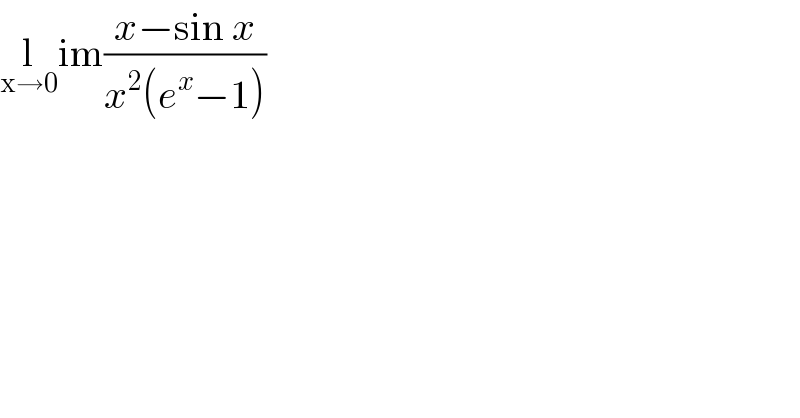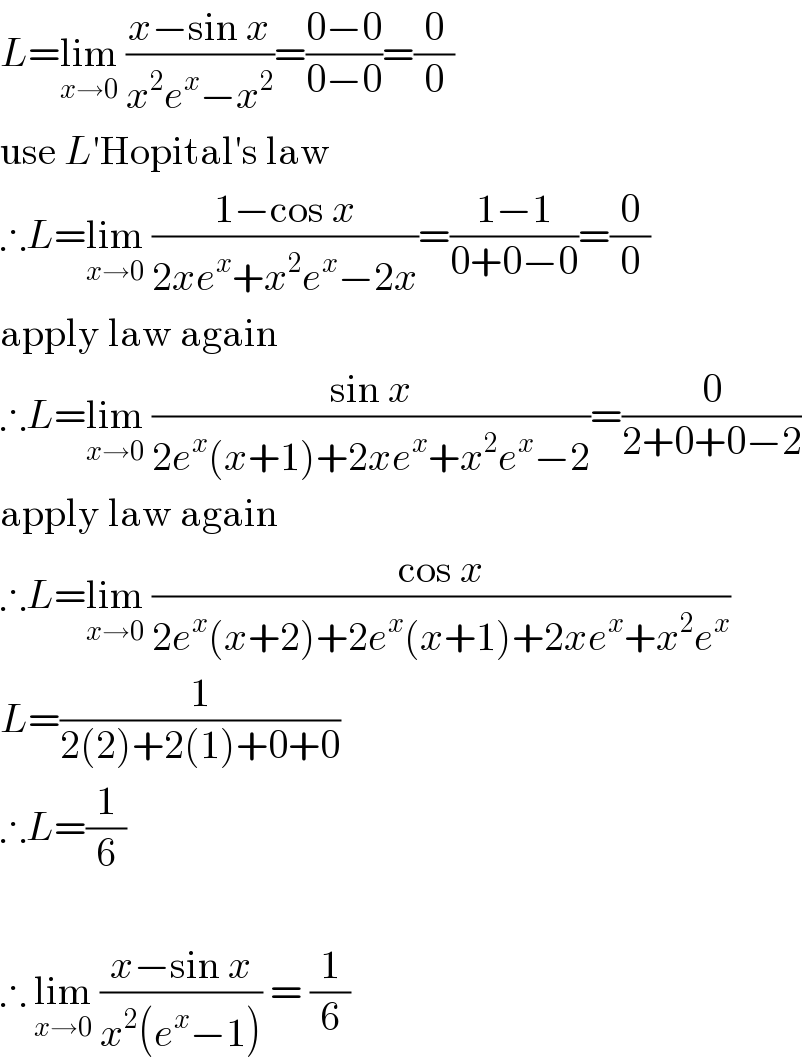Question Number 6703 by love math last updated on 15/Jul/16

$$\underset{\mathrm{x}\rightarrow\mathrm{0}} {\mathrm{l}im}\frac{{x}−\mathrm{sin}\:{x}}{{x}^{\mathrm{2}} \left({e}^{{x}} −\mathrm{1}\right)} \\ $$
Answered by FilupSmith last updated on 15/Jul/16

$${L}=\underset{{x}\rightarrow\mathrm{0}} {\mathrm{lim}}\:\frac{{x}−\mathrm{sin}\:{x}}{{x}^{\mathrm{2}} {e}^{{x}} −{x}^{\mathrm{2}} }=\frac{\mathrm{0}−\mathrm{0}}{\mathrm{0}−\mathrm{0}}=\frac{\mathrm{0}}{\mathrm{0}} \\ $$$$\mathrm{use}\:{L}'\mathrm{Hopital}'\mathrm{s}\:\mathrm{law} \\ $$$$\therefore{L}=\underset{{x}\rightarrow\mathrm{0}} {\mathrm{lim}}\:\frac{\mathrm{1}−\mathrm{cos}\:{x}}{\mathrm{2}{xe}^{{x}} +{x}^{\mathrm{2}} {e}^{{x}} −\mathrm{2}{x}}=\frac{\mathrm{1}−\mathrm{1}}{\mathrm{0}+\mathrm{0}−\mathrm{0}}=\frac{\mathrm{0}}{\mathrm{0}} \\ $$$$\mathrm{apply}\:\mathrm{law}\:\mathrm{again} \\ $$$$\therefore{L}=\underset{{x}\rightarrow\mathrm{0}} {\mathrm{lim}}\:\frac{\mathrm{sin}\:{x}}{\mathrm{2}{e}^{{x}} \left({x}+\mathrm{1}\right)+\mathrm{2}{xe}^{{x}} +{x}^{\mathrm{2}} {e}^{{x}} −\mathrm{2}}=\frac{\mathrm{0}}{\mathrm{2}+\mathrm{0}+\mathrm{0}−\mathrm{2}} \\ $$$$\mathrm{apply}\:\mathrm{law}\:\mathrm{again} \\ $$$$\therefore{L}=\underset{{x}\rightarrow\mathrm{0}} {\mathrm{lim}}\:\frac{\mathrm{cos}\:{x}}{\mathrm{2}{e}^{{x}} \left({x}+\mathrm{2}\right)+\mathrm{2}{e}^{{x}} \left({x}+\mathrm{1}\right)+\mathrm{2}{xe}^{{x}} +{x}^{\mathrm{2}} {e}^{{x}} } \\ $$$${L}=\frac{\mathrm{1}}{\mathrm{2}\left(\mathrm{2}\right)+\mathrm{2}\left(\mathrm{1}\right)+\mathrm{0}+\mathrm{0}} \\ $$$$\therefore{L}=\frac{\mathrm{1}}{\mathrm{6}} \\ $$$$ \\ $$$$\therefore\:\underset{{x}\rightarrow\mathrm{0}} {\mathrm{lim}}\:\frac{{x}−\mathrm{sin}\:{x}}{{x}^{\mathrm{2}} \left({e}^{{x}} −\mathrm{1}\right)}\:=\:\frac{\mathrm{1}}{\mathrm{6}} \\ $$
Answered by sou1618 last updated on 15/Jul/16

$$=\underset{{x}\rightarrow\mathrm{0}} {\mathrm{lim}}\frac{{x}−{sinx}}{{x}^{\mathrm{2}} \left({e}^{{x}} −\mathrm{1}\right)} \\ $$$$\:\:\:\left(\because\underset{{x}\rightarrow\mathrm{0}} {\mathrm{lim}}\frac{{e}^{{x}} −\mathrm{1}}{{x}}=\mathrm{1}\right) \\ $$$$=\underset{{x}\rightarrow\mathrm{0}} {\mathrm{lim}}\frac{{x}−{sinx}}{{x}^{\mathrm{3}} } \\ $$$$ \\ $$$${L}=\underset{{x}\rightarrow\mathrm{0}} {\mathrm{lim}}\frac{{x}−{sinx}}{{x}^{\mathrm{3}} } \\ $$$${x}=\mathrm{3}{t} \\ $$$$=\underset{{t}\rightarrow\mathrm{0}} {\mathrm{lim}}\frac{\mathrm{3}{t}−{sin}\mathrm{3}{t}}{\mathrm{27}{t}^{\mathrm{3}} } \\ $$$$\:\left(\because{sin}\left(\mathrm{3}{t}\right)=\mathrm{3}{sint}−\mathrm{4}{sin}^{\mathrm{3}} {t}\right) \\ $$$$=\underset{{t}\rightarrow\mathrm{0}} {\mathrm{lim}}\frac{\mathrm{3}{t}−\mathrm{3}{sint}+\mathrm{4}{sin}^{\mathrm{3}} {t}}{\mathrm{27}{t}^{\mathrm{3}} } \\ $$$$=\underset{{t}\rightarrow\mathrm{0}} {\mathrm{lim}}\frac{\mathrm{3}{t}−\mathrm{3}{sint}}{\mathrm{27}{t}^{\mathrm{3}} }+\frac{\mathrm{4}}{\mathrm{27}} \\ $$$$=\frac{\mathrm{1}}{\mathrm{9}}\left(\underset{{t}\rightarrow\mathrm{0}} {\mathrm{lim}}\frac{{t}−{sint}}{{t}^{\mathrm{3}} }\right)+\frac{\mathrm{4}}{\mathrm{27}} \\ $$$$=\frac{\mathrm{1}}{\mathrm{9}}{L}+\frac{\mathrm{4}}{\mathrm{27}} \\ $$$$ \\ $$$${L}=\frac{\mathrm{1}}{\mathrm{9}}{L}+\frac{\mathrm{4}}{\mathrm{27}} \\ $$$$\frac{\mathrm{8}}{\mathrm{9}}{L}=\frac{\mathrm{4}}{\mathrm{27}} \\ $$$${L}=\frac{\mathrm{1}}{\mathrm{6}} \\ $$$$ \\ $$$$\therefore\underset{{x}\rightarrow\mathrm{0}} {\mathrm{lim}}\frac{{x}−{sinx}}{{x}^{\mathrm{2}} \left({e}^{{x}} −\mathrm{1}\right)}=\frac{\mathrm{1}}{\mathrm{6}} \\ $$
